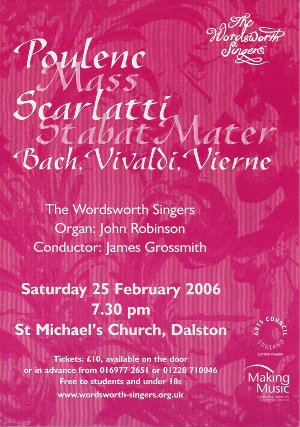Guest Musicians
John Robinson
Emma Harper
Anne-Marie Kerr
Dominic Peckham
James Johnson
Venues
Maza Gilde, Riga
Penrith Methodist Church
St Michael’s Church, Dalston
Carlisle Cathedral
St Andrew’s Church, Greystoke
Tour of Lithuania and Latvia

Maza Gilde, Riga
After hearing the opening bars of The Wordsworth Singers’ performance in Maza Gilde in Riga on 25th July 2006, it was immediately obvious that this was going to be an exciting event.
The choir has a wide dynamic range and sings with a nice, educated sound. The Wordsworth Singers’ soft singing was particularly fine, wonderful singing indeed. The choir displayed precision and a full range of dynamics in Brahms’ Neue Liebesliederwalzer, op. 65 and Fünf Gesänge, op. 104. This was a beautiful performance – well disciplined and with great charm. It was also strengthening the ties between our countries, introducing new music to Latvians.
The part of the concert with music by Dvořák was an emotional one for me, although I found out later that I was not alone. Aside from the highly charged emotions, the sound and evenness which all choirs try to achieve, together with singing from the heart, made for pure magic. It was a pleasure to create friendship with The Wordsworth Singers and we hope to see this wonderful choir in Riga again one day.
Gunta Malēvica
Conductor of Riga Chamber Choir
Comments from audience and sponsors:
“A great honour and privilege [to host the Wordsworth Singers’ visit], of benefit not only to us but to the people of other cities and towns of Lithuania as well as other countries. … Your visit and wonderful performances will remain in everybody’s minds and memories.”
“The quality of the choir …is really top notch.”
“You clearly enjoyed a warm, heartfelt and richly deserved reception from your audiences, and triumphantly carried out a truly remarkable cultural project which will have made an unimaginable impact.”
Songs of Love and Longing
Penrith Methodist Church
27 May 2006
The Wordsworth Singers are off on tour to Lithuania shortly and we were treated to some of the repertoire they are taking with them.
It was a challenging programme, most of it a capella in Czech and German, and it came off splendidly. The choir musically danced their way through the centrepiece of the luscious Brahms Liebeslieder waltzes. They gave us a wide range of expressive qualities, though a few entries and the balance suffered a bit from having no conductor out front. The piano accompaniments, plus the well-chosen Slavonic dance piano duet interludes from Ian Ryan and Michael Bawtree, were light and flexibly played with energy.
This fine choir is improving every time I hear them and having a new and up-and-coming musical director, James Grossmith, is clearly having benefits. A colleague of his, Michael Bawtree, directed the choir on this occasion with clarity and precision.
The only thing I missed was a stronger, earthier tone quality for the first set of Dvorak songs – they were a bit too sweet and English for my taste. But then, their gusto and humour in the refreshing English folksongs that finished the programme couldn’t have been bettered.
Anice Paterson
Poulenc Mass, Scarlatti Stabat Mater
St Michael’s Church, Dalston
25 February 2006

The Wordsworth Singers under James Grossmith were joined by Carlisle Cathedral assistant organist John Robinson. He started the programme with a Bach Adagio, and then provided the continuo for Scarlatti’s Stabat Mater, a long, taxing work with the voices in 10 parts.
The opening built splendidly to a tutti of some grandeur, but there were uncomfortable moments later on.
Small solos emerged from the choir, but Paul Hutchinson and Mary Hitch had longer virtuosic passages. The Amen was impressive, with great waves of sound.
Bach’s Organ Concerto in A minor, its vigorous outer movements framing a beautiful aria over a pulsating bass, was followed by Poulenc’s Mass in G, a difficult work with angular melodies contrasting with complex legato chord progressions. It was an interesting idea to intersperse the movements with organ pieces by Vierne, but for me it broke the flow and mood.
The Singers performed magnificently. The ethereal Christe eleison floated between the robust Kyries, the chording in the Gloria was spot on, Hosannas rang out in rich chords, Mary Hitch’s melismatic solo opened the Agnus and the whole work ended in peaceful resolution.
Douglas Cook
Messiah
Carlisle Cathedral
20 December 2005
Under conductor James Grossmith, the singers gave a spirited and highly-disciplined account of Handel’s Messiah. The florid challenges that Handel continually sets the chorus were brilliantly met, often at very fast speeds.
However the experiment of mixing the chorus up – the 12 men interspersed among the 21 women, was only partly successful, detracting from Handel’s contrapuntal skill in such choruses as Let us break their bonds asunder.
No praise can be too high for the two female soloists, Emma Louise Harper (soprano) and Anne-Marie Kerr (alto), who sang with great beauty of tone. Tenor Dominic Peckham and bass James Johnson also gave sterling performances in their demanding arias.
The orchestra – just 15 young players – performed with commitment and skill. I did find many of the fashionable fast tempi for the largo and larghetto sections detracted from the pathos of the more reflective parts, but these reservations apart, it was a splendid evening of singing and playing.
David Sutton
Music of the Virgin Mary
St Andrew’s Church, Greystoke
24 September 2005
The Wordsworth Singers presented another of their fine concerts of a cappella singing at St Andrew’s in Greystoke on September 24.
Starting with Palestrina’s beautiful motet Assumpta est Maria, they went on to sing the associated mass, followed by a similar pairing by Palestrina’s much less-known contemporary, Luca Marenzio.
Palestrina’s smooth texture and complex polyphony made a striking contrast with Marenzio’s jaunty rhythms and sudden antiphonal effects.
The singers conveyed these to good effect, with some fine solo singing from members of the choir.
But probably the most notable part of the programme came at the end, with two pieces not heard in Britain before by the still-living former director of the Sistine Chapel Choir, Domenico Bartolucci.
Bartolucci combines the traditional idiom of papal music with later melody and harmony in a remarkable way.
The singers were very successful in conveying the urgency and intensity of his Stabat Mater and Pax in Coelo. This second piece is a sort of concerto for soprano and choir, with the solo part working sometimes independently, sometimes in contrast and sometimes in combination with the choir.
Fiona Weakley’s lovely tone and controlled line made this a most moving experience. Director James Grossmith is clearly getting the best out of this talented choir.
David Raeburn


